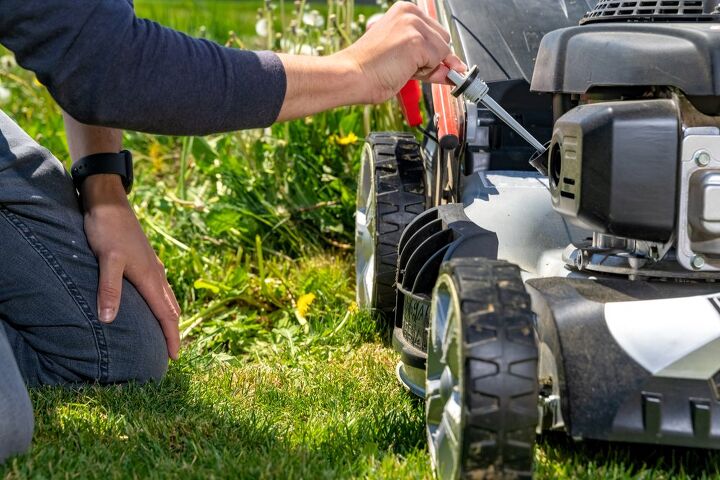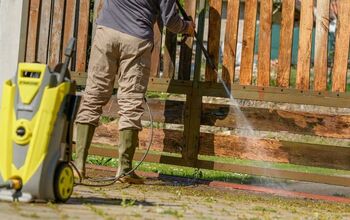Kohler Engine Cranks But Won't Start (Possible Causes & Fixes)

Kohler produces a wide array of outdoor lawn care tools, primarily trimmers and lawnmowers. In a crowded lawncare market, Kohler is one of the most recognizable and trusted names on the market. But that doesn’t mean their products are immune to issues.
Inspect the spark plug for a carbon buildup or cracks, and replace it if the electrodes are damaged. Test the ignition coil and replace it if it spark plug is fine but the engine still won’t start. Make sure that your engine has the right oil and fuel levels, and fill it up if it doesn’t so it will start.
Do You Need a Mower Repair Service?
Get free, zero-commitment quotes from pro contractors near you.

What is the Purpose of the Engine Cranking?
In combustion engines, there are a variety of components working in unison to get the entire thing working. Cranking is the process of turning the engine over; you generally know this through the starter as you turn the key on your mower.
Depending on your style of mower and model, the testing purposes could be a little different, but they are mostly the same. It is likely due to a lack of power to one of the major components, preventing the engine from turning over and getting started.
Check the Spark Plug First
For most combustion engines, at least those in your outdoor lawn care equipment, the most likely cause for issue is the spark plug. The spark plug sends the proper voltage required to get the engine cranking.
1. Look for damage. Take a look at the spark plug to see if there are noticeable signs of wear and tear or damage.
2. Replacing the spark plug. Should there be heavy carbon buildup near the electrode, the porcelain insulator shows cracking or chipping, or one of the electrodes has been damaged or burned away, there is no other solution than to replace the spark plug entirely.
3. Test the spark plug. If the spark plug shows no discernable signs of wear and tear, you can test its continuity using a spark plug tester. When the spark plug is working properly, you will see a strong spark between the terminals of the tester as the engine gets cranking. No spark means that the spark plug is defective and needs to be replaced.
It Could be the Ignition Coil
The purpose of the ignition coil is to send the appropriate voltage to the spark plug as the engine runs. When the coil is defective or damaged, the engine won’t start. In most cases, it’s the spark plug that is failing and that should be the first place that you start.
If the spark plug is fine, you can test the ignition coil using an ignition coil tester to verify that it is working properly. Should you notice any damage to the ignition coil, it is better to simply replace the unit altogether.
Check the Oil and Fuel Levels
As dumb as it may sound, one of the common reasons that your engine won’t crack is due to improper oil or fuel levels. Depending on your model, improper oil levels (typically lower than normal) will lead to the engine not cranking.
1. Check the oil. It is meant to protect your engine from excessive friction that could damage or destroy some of the internal components. It is always a good idea to check the oil level before starting up your mower.
2. Check the fuel. Likewise, check to ensure that you have enough fuel before starting up the mower. In most cases, when the fuel level is too low, it can cause some sticking or clogging in the various components of the engine and will need to be cleaned before using.
Checking Out Some Other Basics
There are plenty of other basic things that can lead to your engine not turning over or cranking. In addition to basic fuel and oil levels, it is a good idea to check out the gas tap as well. Depending on your model, there could be a gas valve that needs to be turned on. When it is off, it will stop the flow of the gas to the carburetor.
Battery Charge. Another simple thing to check for is whether or not the battery has been charged. Similar to the spark plug, a faulty battery is one of the most common causes for a motor that won’t crank or turn over. If the engine sounds like it isn’t cranking normally or is doing so at a less than optimal speed, you can try to jump-start it to potentially rule out whether or not the battery is weak.
Plug Wire. From time to time, the plug wire can come loose; this is actually a fairly common occurrence and makes for a quick fix. This wire will usually live right at the very front of the engine. Since the engine vibrates quite a bit and this component is a push on fit, it is possible for the metal plug cap connection to widen and eventually become loose.
Air Filter. Another very common cause of combustion engine issues is the air filter. When the air filter gets clogged up with debris or blocked entirely, it can and will prevent the mower from starting. Make sure that you check the condition of the air filter every once in a while. A good rule of thumb is that it should be checked after 25 hours of use.
It Could Come Down to the Gas/Air Mix
When it comes to combustion engine issues, one of the most common issues is the fuel in one way or another. The reason for this is that some fuels are ethanol-blended. Though some manufacturers say that you should run your equipment on this fuel, you may be better off using regular gas as most of these engines aren’t designed to run on ethanol fuel.
Using a Fuel Stabilizer. Depending on your model, using a fuel stabilizer may be a good idea. These are meant to protect against the negative impacts of fuel that has been sitting for long periods of time. Remember, when fuel sits, it evaporates and can create a sticky substance that clogs up several different components.
If you tend to let your mower sit for quite a while, particularly during the winter, using a fuel stabilizer can be a great way to not only preserve the fuel within the tank but to protect the other components of your mower.
Clean Air. Just as important as the fuel is clean air. When the air filter goes bad, your engine won’t get the proper mixture of gas and air that it needs to function properly. Additionally, when there is too much fuel and not enough air, the engine can get flooded and will stop working.
Is it the Control Module?
The control module will come on most of the modern mowers out there and are meant to process the safety signals throughout the mower for extra protection. In some, but not all, cases they are implemented into the dash light panel. Most of these are basic circuits with relays and resisters.
Over time, modules can fail due to overexposure to moisture. If your mower doesn’t have a control module, it is the ignition switch that is doing all of the work. The advantage of having the module makes it easier to find fault within the system.
What About the Ignition Switch?
The good thing about ignition switches is that they are all pretty basic and you can test them using a digital voltmeter. The only thing that varies is the number of pins at the rear; this can depend based on the model.
While ignition switches typically are not the issue, they can fail from time to time, particularly when the terminals start to corrode. Testing the outputs and inputs is certainly possible, though visual inspection for damage is certainly possible.
Do You Need a Mower Repair Service?
Get free, zero-commitment quotes from pro contractors near you.

Running the Gas Shot Test
The best way to determine the issue with your mower and why it may be ranking but not working properly is the gas shot test. In essence, you need to narrow down the potential area for fault to save yourself time and find the issue.
Since most issues with non-starting mowers lay somewhere in the fuel system, starting with the gas shot test makes the most sense. To run the test, you’ll need two things: fresh gas and to remove the air filter. It is important to know that if the gas is not fresh, this test will not work as intended.
1. Remove the air filter. To remove the air cover and filter, it will depend on the model. Some might have wing nuts, some might have screws, while others will simply pull loose.
2. Dropping the gas. Fill up a bottle cap with some gas and drop it directly into the carburetor. You will then need to attempt to start the mower as you normally would with the full choke.
3. Test the spark plug. If the mower doesn’t start at all, you can safely assume that the spark system is at fault; most likely the spark plug in general. If the mower at least tries to starts or manages to do so successfully, you can be confident that the issue lay within the fueling system.
Related Guides

Ryan Womeldorf has more than a decade of experience writing. He loves to blog about construction, plumbing, and other home topics. Ryan also loves hockey and a lifelong Buffalo sports fan.
More by Ryan Womeldorf
















![Standard Dining Room Table Dimensions [for 4, 6, 8, 10 and 12 People]](https://cdn-fastly.upgradedhome.com/media/2023/07/31/9074335/standard-dining-room-table-dimensions-for-4-6-8-10-and-12-people.jpg?size=350x220)










